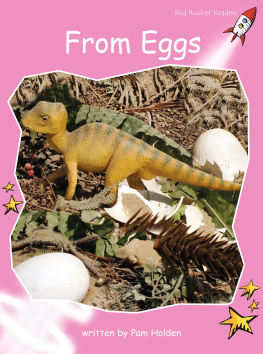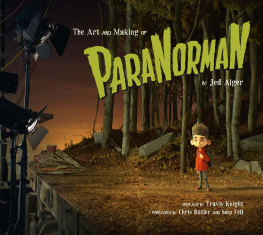


Copyright 2014 Boxtrolls, LLC.
Licensed by Universal Studios Licensing LLC.
All rights reserved. No part of this book may be reproduced in
any form without written permission from the publisher.
Library of Congress Cataloging-in-Publication Data is available.
ISBN: 978-1-4521-2835-1 (hc)
ISBN: 978-1-4521-4299-9 (epub,mobi)
Designed by Cat Grishaver
First page: Jenn Ely digital
Title page: Michel Breton digital
This page: Paul Lasaine digital
Chronicle Books LLC
680 Second Street
San Francisco, California 94107
www.chroniclebooks.com

Preface

 by Travis Knight
by Travis Knight 

I d really done it this time. I was bleeding. A lot. The parties responsible, an errant splinter of razor-sharp armature wire and my own fumbling, traitorous hands, conspired to form the rivulet of blood spilling down my fingers and spattering on a miniature cobblestone street, swelling into a comically oversized puddle of gore. Id gone and accidentally cut myself. Again. Idiot. The good news was that I was animating in a drafty, ramshackle warehouse in the stony heart of winter. Which meant my set was cold. Really cold. Which meant my frozen hands were blissfully numb to my bloody, weeping finger stumps. But in a job where chronic muscle aches, twisted ankles, scalded flesh, and otherwise bruised and battered bodies are an everyday occurrence, a little bloodletting is hardly a novel experience. It is, I suppose, the life of a stop-motion animator.
Stop-motion is a pain in the ass. Its hard and it hurts. Its also achingly beautiful; a rare and captivating art form with a kind of gritty, hard-fought nobility. Steeped in over a century of history and tradition, stop-motion animation stems from late nineteenth-century stage magicians looking for new ways to bring their illusions to life. Infusing their creations with magic, these earliest filmmakers dusted the process with a primal glamour as they roused inanimate objects to astonishing, waking life. Inevitably, after decades of sparking imagination and awe with only their ingenuity and their dexterous hands, stop-motion animators eventually fell prey to the inexorable march of technology. The computer usurped the craftsman. Stop-motion was dead. But we werent convinced.
At LAIKA, we are descendants of those early magicians. We are devoted zealots of stop-motion animation and its inherent power to inspire joy and wonder. Yet we also believe the art forms potential has been largely untapped. And we believe we can reinvigorate it; bring it into a new era by aligning with the author of its purported demise: the infernal machine. In effect, we are Luddites who have embraced the loom. Blending oldschool handcrafted workmanship with cutting-edge technology, LAIKA artists draw from the theater, the stage, and the tech lab. Our characters and worlds are spawned from pencil and paper, sculpted by human hands, designed with computers, and manufactured by machines. Within the studios walls, cinemas history collides with its future, intermingling creative talent and technology in a kind of swirling alchemy. The final, vital ingredient is a story, a moving and human story. We found such a story in Alan Snows novel Here Be Monsters!
Nearly ten years ago, I read Alans book and was utterly spellbound. His dreamed-up universe was an imaginative and unique creation, with whispers of the very best of classic childrens literature. Populated with fantastical creatures, unlikely heroes, and good-for-nothing reprobates, Here Be Monsters! shimmered with the bizarre vitality of Charles Dickens entwined with Monty Python and Roald Dahl. It was bold. It was weird. It was grand. Perhaps a bit too grand, as it proved a punishing effort to distill the coruscating essence of a five-hundred-page novel down to a compelling ninety-minute film. Simply put, there was just too much story in our story. Painstakingly, we trawled through the exquisite minutiae of the book intent on rooting out a clear and dramatic film story. One with gravity and originality and emotional resonance. In the end, our solution came in the form of two gifted, albeit fairly strange, men.

Graham Annables desk sat a mere fifty feet from mine. Habitually hunched over his notebook or Cintiq, Graham sketched feverishly and prolifically, drafting hilarious gags, affecting emotional moments and lovely and elaborate cinematic compositions as a matter of course. His work was a pillar of our two previous films, Coraline and ParaNorman. Graham was one of LAIKAs finest story artists, blessed with the perfect combination of smarts, vision, and twisted sense of humor to lead this project from the page to the cinema. His eventual directing partner, was not nearly as conveniently located. He wasnt in the building. He wasnt even in the state.
Id known Anthony Stacchi by reputation as an intense, inventive, and insanely talented story artist and film director. We first met during Anthonys visit to the studio during the production of Coraline. In person, Anthony was funny, charming, and quick-witted, ideal qualities for a films potential creative leader. Unfortunately for LAIKA, he was also quite content with his life in L.A. It took an animators patience and perseverance to entice Anthony away from the blithe, sun-soaked splendor of Southern California to the gray, dreary, rain-soaked Pacific Northwest, 950 miles distant and a world apart from his wife and newborn son. In those careworn early days of the films development, Anthonys unsparing interstate commute amplified a tension that plagues all parents: the precarious, elusive balance between family and meaningful work. It was within that tension, that we found the beating heart of our story.
In a way, a work of art is a Trojan horse. Shrouded beneath the surface of a book or painting or film is an artists personal story or deeply held philosophy, anxiously poised, ready to slink out unseen and pounce with striking, violent impact. For The Boxtrolls, our story was both personal and societal, exploring the meaning of family, the intimate connections between parents and their children, juxtaposed against a stately Victorian backdrop stained by bigotry and corruption. The world of Cheesebridge provided us a vast canvas to daub layers of metaphor, and the Boxtrolls themselves offered a potent symbol to infuse with meaning. They became an emblem of the disenfranchised, the undesirables, the unjustly condemned whipping boys for societys innumerable ills. Whats more, we found shades of ourselves in these quirky, hideous little monsters. The Boxtrolls, a band of shy, inarticulate, socially awkward cave dwellers, with dubious personal hygiene and questionable fashion sense, are in fact spirited artisans who reshape useless scraps of detritus into sparkling creations of invention. In other words, the Boxtrolls are essentially stop-motion animators. God help us.
Next page












 Preface
Preface 
 by Travis Knight
by Travis Knight 

